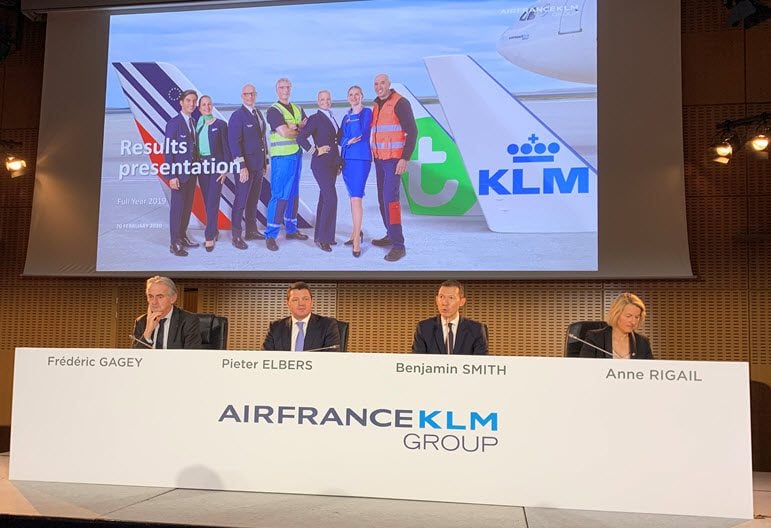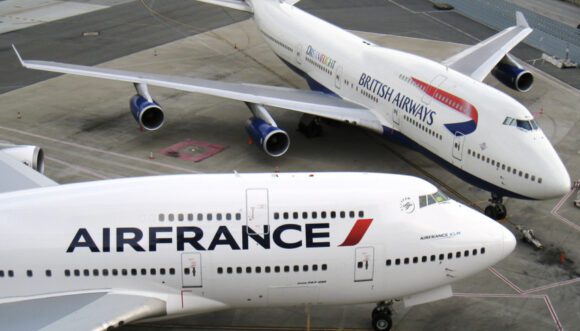
2020 02 20 11 06 56
Higher revenues, more passengers, but still a lower net result. That describes the fiscal year 2019 for Air France-KLM. The Franco-Dutch airline group recorded a net income in 2019 of EUR 290 million compared to 420 million in 2018 (a restated result from the 409 million previously announced). While disappointing at first glance CFO Frederic Gagey still regards 2019 as a positive year with a “good increase in income and a positive reduction in unit costs by 1.5 percent.”
Air France, KLM, and its low-cost leisure airlines Transavia and Transavia France flew a combined 104.2 million passenger last year, up from 101.4 in 2018. Income from operations was EUR 1.141 billion, down from 1.405 billion. Revenues were EUR 27.188 billion versus 26.224 billion the previous year.
Looking at the income of operations per quarter, 2019 wasn’t that favorable compared to 2018. In Q1, it was EUR -286 million versus -152 million the year before, in Q2 423 million versus 389 million, Q3 909 million versus 1.088 million. Q4 produced only a EUR 96 million operating profit compared to 53 million the year before. Net debt was 17 million lower.
While an improvement, Gagey stressed how difficult Q4 has been, with a drop in long-haul traffic by 1.1 percent but a 4.2 percent increase on short to medium-haul. The fourth quarter has always seen weaker traffic, Gagey explained, although that doesn’t apply to all airlines: Ryanair’s strong December-month confirms something different.
Cargo suffered hugely in Q4 with unit costs down 17.1 percent or losing EUR 99 million in one quarter. Cost measures partly mitigated the effects and helped to get EUR 559 million in cargo revenues for the quarter. FY19 cargo revenues ended at EUR 2.153 billion (-5.9 percent).
KLM outperforms Air France again
By airline, KLM once again out-performed Air France with an operating margin of 7.7 percent versus 1.7 percent.
KLM’s net operating result was EUR 853 million, down from EUR 1.091 billion in 2018, with revenues at EUR 11.075 billion. This included the effects of the September-strikes, which disrupted schedules but according to Pieter Elbers only cost the airline “a couple of millions.” The impact of a sluggish cargo market had a much deeper impact on the results of the Flying Dutchmen.
Air France Hop ground most likely staff will go on strike this Friday again followed by pilots later, which doesn’t bode well for 2020. Last year, AF operated without major labor conflicts that cost it EUR 335 million in 2018. Yet, the French ended the year with a EUR 280 million operating result, down 41 million from 2018.
Gagey acknowledges the difference: “We do have a margin-gap between Air France and KLM. Air France has to reduce this gap and I am happy to say that we are seeing effects. If not so much in the full year-results you can see it in Q4. It isn’t a question of competition between the two, but our plan is to improve AF’s situation in 2020.” Ben Smith called execution of the transformation plan one of this year’s priorities, which includes simplifying and renewing the fleet, restructuring the domestic network, maximize turnover, and develop new revenue streams. Ancillary revenues should grow by 23 percent this year.
More pax but lower result for Transavia
Transavia reported a net result of EUR 131 million, down from 145 million. This despite 4.8 percent more passengers to 16.6 million and 9.3 percent higher revenues to EUR 1.744 billion. Higher unit costs (+4.8 percent) were caused by fleet related and non-performance costs, which included instructor training for Transavia France. Since the French low-cost reached an agreement with the unions in September that allows it to grow beyond 40 aircraft, Transavia France has leased two additional Boeing 737-800s to bring the fleet to 40 sharp in 2020.
The bigger fleet will be used to open up twelve new routes to Algeria from six destinations including the new hub Montpellier, routes previously operated by XL Airways and Aigle Azur before they went bankrupt. Air France will also add five new routes into Algeria. The demise of the two private French airlines allows Air France and Transavia France to strengthen their position at Paris Orly and improve its operating cost structure at Paris’ second airport.
Air France-KLM Maintenance recorded a positive year, with revenues up 6.2 percent to EUR 4.617 billion and an operating result of 260 million. By January 1, the unit had a maintenance order book of EUR 11.5 billion which means five years of business, Gagey explained.
Coronavirus and oil prices unknown factors
The Group seemed set for a year of further improvements, with good performance in unit revenues evident in January. But since February the situation is unclear since the outbreak of the coronavirus Covid-19, with bookings down 3 percent in February, 5 percent in March, before stabilizing to 3 percent again in May. As things stand now, Air France-KLM expects the operating result to be EUR 150 to 200 million lower until April on the condition that services to China will re-start again that month. Air France used to operate 27 daily services into China, KLM 25, reflecting 5.5 percent of all traffic within the Group.
The negative impact of Covid-19 on results might be more than compensated by the drop in oil prices since January. If prices stay low, Frederic Gagey expects his fuel bill to be some EUR 300 billion lower compared to last year’s 5.5 billion.
Fleet updates
On fleet and product, KLM’s Pieter Elbers said his airline will introduce Premium Economy in long-haul, replacing the current Economy Comfort seat available on some types.
Group CEO Ben Smith said there are no immediate plans to replace the short- to the medium-haul fleet at Air France or KLM: “You’ll know our capital expenditure (Capex) is restricted, we can’t replace our fleet at once. We have made important decisions on the long-haul fleets (Airbus A350s for Air France, more Boeing 787s and 777s for KLM) and short-haul (A220’s for Air France). Let’s wait and see how the A220s perform and maybe there will be a bigger version…”, he tells Airinsight. Another reference to the A220-500, which already was on a slide presentation on last November’s Capital Markets Day.
The unresolved situation of the Boeing MAX makes it difficult to decide on any order for the type for either KLM or Transavia. In a sense, the situation buys Air France-KLM some time to decide. Elbers confirmed that KLM is having a look at both the MAX and the Airbus A321neo/XLR, although from a fleet standardization and cost perspective keeping a Boeing-only would be the most sensible thing to do.
Air France CEO Anne Rigail said that 80 percent of the fleet’s cabins will be modernized, half of which to be completed by the end of this year.
Views: 6





